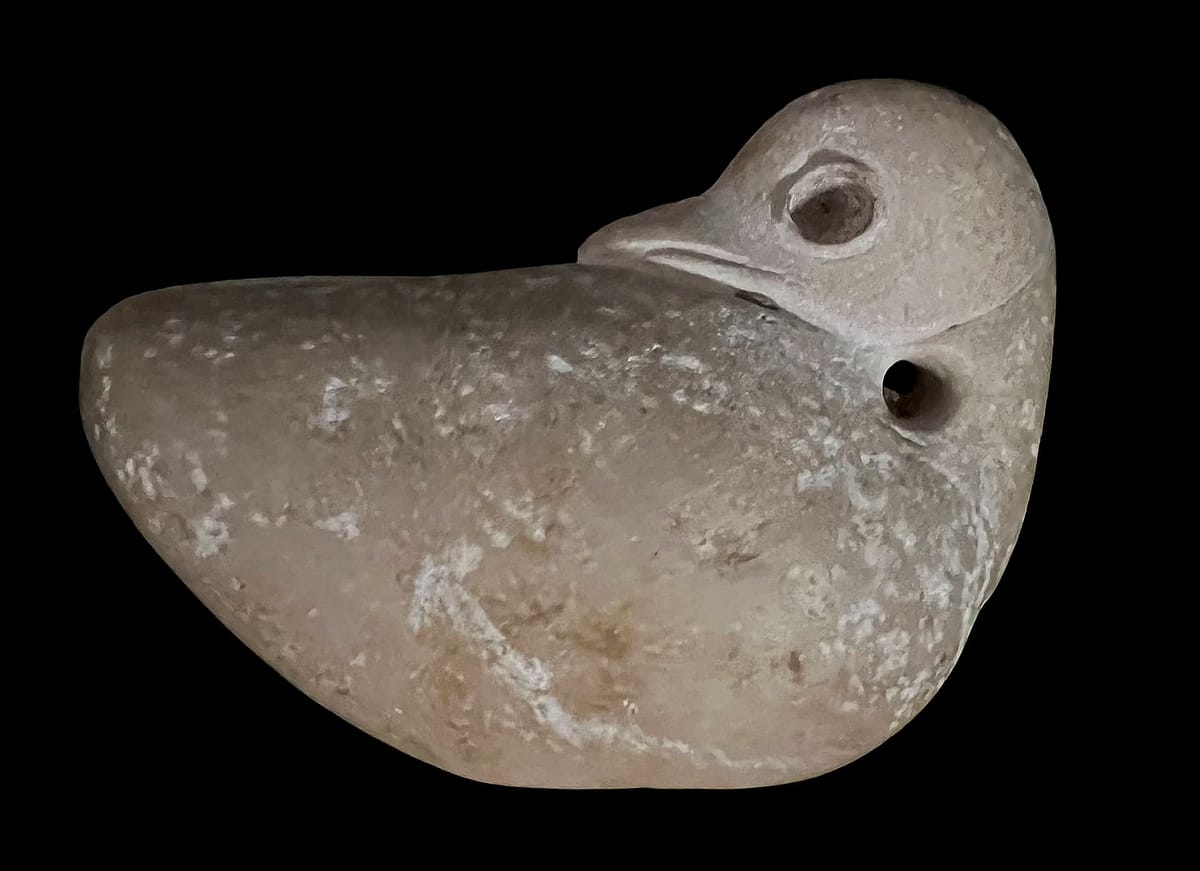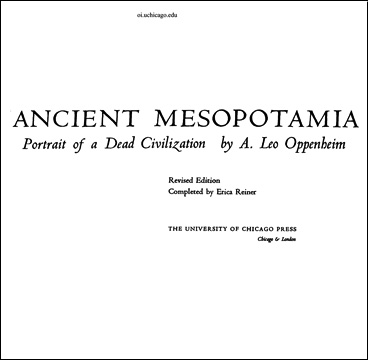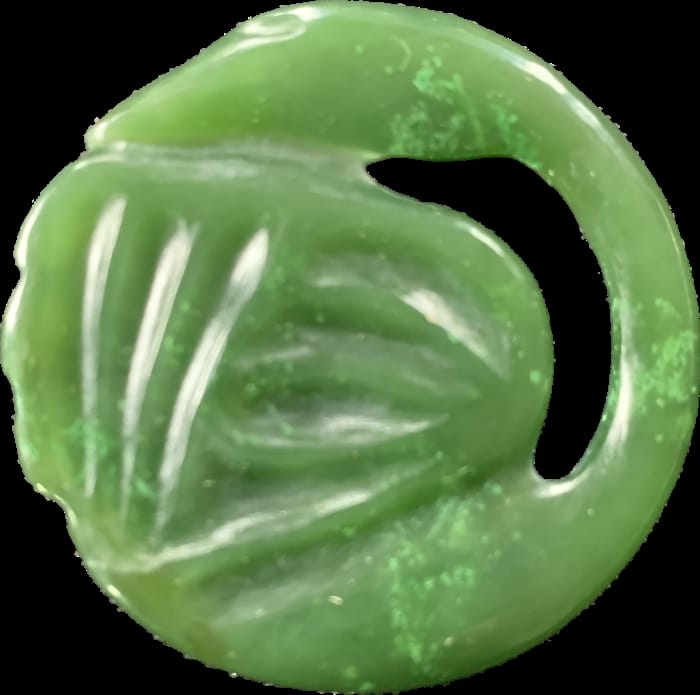Babylon, Weights and Measures, and the Origins of Civilization
Dr. Josh Stout discusses how this simple duck weight artifact can directly connect us to cultures from millennia in the past - and can support his theory of the discovery of a previously unrecognized culture.

Below is lightly a edited AI generated transcript and there may be errors. Please scroll down for links below the transcript.
Eric:
Here we go. Mind-Body Evolution on video. Thanks for watching, everyone. This is Dr. Josh Stout.
Dr. Josh Stout:Hi. Nice to see you.
Eric:What do you got for us today, Josh?
Dr. Josh Stout:I want to keep talking about the, let's call it a previously undescribed culture
that I seem to have perhaps found online.
Eric:This is continuing on from our last
Dr. Josh Stout:I was looking online at random things being sold and noticed that there was a group of similar well-carved statuettes and started buying them and realized that there might be a connection between them.
Dr. Josh Stout:I was looking at a site that sells almost entirely fake antiquities and I started realizing that there was a collection of maybe not fake antiquities hidden amongst them so that they were not correctly labeled but spread out through all the other things for sale so that there were real ancient artifacts with the fake ancient artifacts. So after looking at thousands and thousands of fakes I've picked out a few that may be real and they may represent a completely undescribed civilization which helps them look like fakes because they don't look like the things they're supposed to match. They're roughly Sumerian but they are not the same things as the Sumerian artifacts.
Eric:I want to look at something.
Dr. Josh Stout:So the first thing I want to do is I want to talk about
Dr. Josh Stout:how exciting it is to have artifacts from ancient cultures because it allows us to start to understand the nature of the ancient culture and to see how it relates to our present day.
Dr. Josh Stout:So one of the defining artifacts of Sumerian, Akkadian, Babylonian, Assyrian even the sort of parallel civilizations like Hurrian or the Elamites all of these had a kind of weights and measure system based on stone weights usually carved as a duck and they based their whole system of measuring things on variations in the weights of these ducks.
Dr. Josh Stout:So it was based on a base 60 so like this is where we get our time from our 60 seconds to the minute and 60 minutes to the hour all of that's Babylonian. Our 360 degrees to the circle our 365 days of the year all of these are Babylonian concepts and they're based on this sort of weird base 60.
Eric:These concepts are 4000 years old?
Dr. Josh Stout:It's
Dr. Josh Stout:6,000 years old
Eric:6,000 years old?
Dr. Josh Stout:At least that's when people started writing about them but they were fully formed systems already that
Eric:And why ducks?
Dr. Josh Stout:I don't know people really like ducks it was ducks and frogs things having to do with water and abundance that you could catch and eat. Later it was lion so it had to do with power.
Eric:So I guess in the beginning it had to do with abundance or food
Dr. Josh Stout:or food or the things you wanted and then later it started to turn into power. There was a really interesting period where later Syrian weights were lions and then when the Persian king took over the whole area the Achaemenna dynasty the first coins he put out had pictures of the lions representing worth and the smaller the denomination the smaller the piece of the lion. So you start off with a whole lion then you have the lion's head then you have just the lions arm and finally the smallest one was the lions claw. But these are whole animals done larger or smaller in different denominations on a base 60.
Eric:And the representation of the animals was faithful to the animal itself.
Dr. Josh Stout:More or less, yeah. So let's show the first artifact that I want to show what a typical duck weight would look like. Is it up? No, no. Go to the end. Very good, here we go.
Dr. Josh Stout:So I want to show what a typical duck weight would look like from 6,000 to about 3,000 years ago. So about 3,000 years of this is what duck weights look like. They're really uniform. They're pretty easy to carve. That one was actually an example from a Christie's auction. It sold in something like 2011 for a little over $21, 000. So these are very valuable artifacts.
Eric:Why are people paying $21, 000 for that piece of stone?
Dr. Josh Stout:Because they represent history so strongly. This is a direct connection with the code of Hammurabi with the systems of law that made our own civilization. Look at the curves on this one. This is why that this one, I think, also sold well because it has a very nice curve to it. It's well carved. You can actually see how it was made. See all those little dots on the side of the animal? Those were how it was pecked into shape. You take one stone and you hit it with another. And it leaves that sort of spalled, dotted shape on the side of it. But that's a very nice example. That one would have weighed close to maybe 600 grams, I'm guessing. But just guessing by the shape of it, because those would be the different numbers, the different denominations. So 600 would have fit nicely into a base 60, and that would have been one of the largest sizes you had. So if you're selling something at Christie's, you want the biggest one, and it's going to sell for the most because it's the largest size.
So
Dr. Josh Stout:these came in a variety of sizes and the sizes were very scaled and very, very strict. These were not random, and so you can see how they go down to very, very small things, below the size of a gram, up to something that might have been 600 grams or it could have been double that.
Eric:This, of course, I mean, this does beg the question, how did they standardize this thousands and thousands of years ago
Dr. Josh Stout:So you'd have a king who had a standardized duck set and in the palace-
Eric:So there was one that they were based on that one.
Dr. Josh Stout:That one, and they were all based on it, much like weights and measures today.
Eric:But doesn't this bring, like, the- don't you get into, like, a telephone game issue?
Dr. Josh Stout:You keep copying it and you send inspectors out and you do terrible things to people who fake it. If someone gets caught, really bad stuff happens.
Eric:Okay, so that's what happens in a dictatorship.
Dr. Josh Stout:Right. But it also represents the power of the king. So the ability to actually make the weight shows the power of the king. So new kings would make new sets of weights with different measures. And so the classic Sumerian duck weight weighed about 8 1/2 grams. The biblical period duck weights, the shekel, would have weighed about 12 grams. So these were all measured in shekels. So a shekel is a weight of silver. So about 8 1/2 grams of silver was the original Sumerian version. In biblical Judean times, it would have been 12 grams. It would have been a shekel. And so these are measured in shekels, which are different denominations, depending on what, what empire you were looking at, what king you were looking at. But once you were under that king, you had to be really, really strict. So instead of a system of exchange rates between, sa, dollars and yen, it would be different civilizations. So if you knew which kingdom you were going to, you'd know how much silver their shekels were worth. And so you could actually run the exchange rate by understanding what the differences were. And these were very, very precise. You could get down to fractions of a gram with these weights.
Eric:So I'm assuming that the reason that we're talking about this is that you have a duck weight.
Dr. Josh Stout:Yeah. So I wanted to show one from this particular group of artifacts, and I wanted to show it so that you could see just how different it is from the examples that we've been talking about. I'm on my gloves now so I can pick it up.
So if you're a faker and everyone knows what a duck weight looks like, you're going to make one that looks exactly like that. So here we go.
Dr. Josh Stout:Here is the duck weight. So first of all, you can see it's not quite the same as the one shown in Christie's. It's pierced. It has these inset eyes, which is very Sumerian, but not something you want to have in your weight system. Right? You want it to be very, very controlled. So this would have had stones glued in with bitumen or something into those eye sockets, and that had to be part of it. Also, if you're a faker, you don't want to add drilled holes. That's some work. This was drilled from both sides. It took some work to get in
Eric:So you're saying it's a true fake for say the tourist trade. They wouldn't have bothered with that hole.
Dr. Josh Stout:The whole thing seems strange from a faking point of view. It definitely does not look like a Sumerian duck weight, which was standardized for thousands and thousands of years. And across the area from Persia, even to Egypt, even the Egyptians had those same kinds of duck weights.
And then the inset eyes, you can see that there's rim around it. So they actually sanded the stone down and left this rim around the eye to hold it in place to hold the stone in place better. So it wouldn't fall out. And it's actually typical.
Eric:The inset stones, these are the same inset stones that you were showing last time in the king.
Dr. Josh Stout:The eyes. Yeah. And if you look very carefully at the sockets, they usually have a rim around them, which a faker would have a hard time doing. Because it meant that they lowered the level of the stone all the way around the rim, leaving just this fine rim of stone. Yeah.
Eric:That rim is actually a deceptively difficult-
Dr. Josh Stout:It's deceptively difficult and not something a carver would even bother with because you can hardly see it. You can't see it very well in the pictures online, but it's the kind of detail that you look for if you're trying to verify that something is real.
Eric:So this would be called a fake because it's not from a definable or a known civilization-
Dr. Josh Stout:It's a bad copy. It doesn't match any of the things.
Eric:Even
Eric:though we know these, what you're saying is we know that these were used as weights basically all around the world for a-
Dr. Josh Stout:Well, all around this particular section of the world.
Eric:This
Eric:part of the world. Yeah.
Dr. Josh Stout:From Egypt to Persia.
Eric:This could have been a real, thing that was used.
Dr. Josh Stout:Well, it could have been, but it would have to have been from a civilization that was a little bit different from all of the other ones. And so I don't know where it came from. There were influences of Sumerian civilization all the way out to Oman, Persian Gulf areas. It could have been any one of these things that had taken a concept that was a well known concept and then changed it a little for their particular group. So one thing I wanted to do for verification purposes was weigh it, right? If you're looking at a weight, you want to weigh it.
Eric:Right.
Dr. Josh Stout:And how does it fit into the shekels? Is it going to fit into a known civilization? Is it going to be eight and a half grams to a shekel? Is it going to be 12 grams to a shekel? That would tell me where I was. Is it going to be somewhere in between, which won't necessarily tell me?
Eric:That won't
Eric:tell you anything.
Dr. Josh Stout:And then the other problem is it's not, they weren't using grams when they measured these things. So, right, they were using their own system.
Eric:So it
Eric:was a retrospective understanding of what the weights were.
Dr. Josh Stout:Then I have to figure out how to take the gram measurement and work it into a known system using base sixty.
So, so I have to, I have to use the, the, the Babylonian system.
Eric:You're really
Eric:good at pattern recognition. Math, maybe not so much.
Dr. Josh Stout:I can do, I can do some math. This isn't so hard. This is actually a lot like mass spectrometry, which I've done. Right.
It's really hard to do if you don't know what the possibilities are, but you know, knowing that carbon is a 12, you know, really helps you sort of figure out how many carbons you have when you find the final number, but you've got to add in the, whatever those hydrogens are, et cetera. Anyway. So I'm used to this kind of puzzle. It's a fun puzzle to do, figuring out what the code is. So anyway, I, I, I, I,
Dr. Josh Stout:I took this weight and I weighed it and it came out to 409 grams. Now 41 is a good Babylonian number number. It's a, it's a prime number. It's a magic number, but 40 is even better. 40 days and 40 nights, uh, 40 days in the desert. Uh, a lot of forties come into this stuff. Very magical, very Babylonian. Um,
Eric:but isn't, isn't 40.9 something you round up to 41?
Dr. Josh Stout:You could easily round that up to 41 if it was exactly 10 grams per shekel, but we don't know how many grams per shekel it was.
Eric:Right.
Dr. Josh Stout:So it comes out to a little bit under 10 grams per shekel. So it wasn't the 8.5. It wasn't the 12. It was somewhere in between, but it was working in that same system. And the other thing I, this is why I was trying to hold it up. I, I wanted you to notice these lines on the side. Okay. So those lines were carved on the side. So that's four lines carved on the side. So I think that this was a 40 shekel weight and each one of those lines represents 10 shekels. Okay. And it's a little bit smaller than that one from, from Christie's, uh, in terms of just inches, you know?
Eric:Yeah.
Dr. Josh Stout:Uh, so I think, I think that the one from Christie's was probably a 60 shekel weight. And so even though you're looking at different civilizations, this was what made it useful between different cultures. You would look at the duck. You'd say, Oh, that one's a little bit smaller than the 60 that's probably a 40. And you wouldn't need to know exactly what you were dealing with. You would, you'd be in the right realm. Um, but then once you were in it, the King would have decided very exactly down to fractions of a gram, what a shekel was because you know, these things were mattering when it came to silver, you know, uh, uh, 40 grams of silver. a substantial amount of silver, you know, you, you're, you're, you're, you're, you're talking about some real weight there that would have bought you, you know, several slaves, um, an equivalent weight in, um, uh, in, in grain. Uh, so, so 40.
Eric:It's funny because like whenever thinking about money and how many things you could buy with it, my father always turned it into ice cream.
Dr. Josh Stout:Yeah, no, they, they, they, they had numbers for slaves and grain and silver. Uh, yeah. So those were sort of your denominations for a lot of things. Uh, and, and so they needed to know down to almost, you know, tiny sprinklings of grain, how much something was going to weigh.
Eric:But now when you, when you talk about the, the Sotheby's object, were all of the ones from that period of time that are, that are known to be, you know, verifiably real, did they have that same form? They have that same exact form.
Dr. Josh Stout:They had the same exact form. There are a few later bronze weights that have a hole in the neck that could have been worn as amulets. They're usually small, much smaller than this.
Eric:This, this, this does not look like it could have been, that's pretty heavy.
Dr. Josh Stout:Right, right. There's also some weird marks on the bottom that are not going to show up in a photo, but you see all those dots. There's a, there's a, there's a crescent moon shape there that I think was intentional. Um, and when I did a rubbing of it, I, you could see that it was drilled in there. Uh, and that would have represented, uh, a goddess, uh, the, um, sometimes called sin actually. So it's the marks of sin. Uh, this, uh, this crescent moon shape, uh, representing that goddess, uh, and the other dots there would have, uh, in some versions of the religion and some versions of the, of the language, uh, Akkadian, uh, would have been Marduk, uh, a, a, a, a, another God. So the God and goddess sanctified this piece to say that they were equipped the right weight. Um, but they didn't worry too much about those marks because that was checked and they were just very fine.
Eric:You
Eric:gotta have the king and God behind the money.
Dr. Josh Stout:Yeah, yeah, yeah. So the king and God were, and goddess were behind the money.
Eric:Yeah, yeah, yeah. Sorry, goddess. Yes.
Dr. Josh Stout:Both of them. All three of them. They, they, they worked closely together. Uh, it's, it's really interesting in terms of world history. Uh, these, these are the people who came up with the idea of trinities working together in this, in this kind of fashion.
Eric:Again.
Dr. Josh Stout:Yeah.
Eric:Again, the foundations, the very, the very foundations of, of the way we think.
Dr. Josh Stout:The way we think. Exactly.
Eric:Coming from 6,000 years ago.
Dr. Josh Stout:Yeah. So,
Dr. Josh Stout:so this, this was, uh, the, you know, the first sets of weights and measures. This was, uh, also connected to the first, um, sets of, uh, of, of laws, right? Because if you have an exchange rate, now you have a worth of the money. You have, uh, the king deciding who got cheated, what the penalties are, what the fines are, what happens when you can't pay your bill. When, when you have debt, who owes money to whom? Uh, and so there was independent money lenders. Uh, they would often enslave people who couldn't pay the money back. Uh, there were, uh, temple money lenders, which were actually, you'd get better rates at the temple. And if you owed them money, uh, you didn't have to become a slave. You just had to, um, continuously pay them grain every year. And so they would.
Eric:There, there are, there, there's a, there's a very good theory. There's a whole book on the theory that the debt, debt started before money, before currency.
Dr. Josh Stout:Well, in many ways, it was, it was about,
Dr. Josh Stout:it was about recording what was owed. The, the, the, the original, um, exchanges were for every commodity. So rather than, you know, you, you, you, you hear about barter. So rather than carrying, uh, your goat to market, you would have, I have one goat equivalent. I can either do this in silver or grain, or I could do it in pottery, or I could do it in what, whatever is for sale out there. And that became cumbersome in its own right, because you had to have an exchange rate that was posted for maybe 60 different items. I immediately started thinking in Babylonian sixties and forties and things like that. Um, and so you'd have, they would have, they would have a posted exchange rate time before the printing press, you'd have a posted exchange rate. Well, it was carved in, in not stone, but in, into, into, into, uh, clay. For temporary things, uh, and then stone for permanent things. So coat of hammer ought to be stone, but the exchange rate of the day might be in a clay tablet. So you'd know going into it, but it became cumbersome between all these different items. So then they started doing it to just grain and silver. And so that's when the shekel first became denominated. And it wasn't so much that there were coins, but rather there were weights. So you'd know how much silver or grain, it didn't matter the form of these things. So, so it's before money per se, but it's the concept of value based on weight of a thing. And then the understanding of value between these things.
Eric:And the, the concept of value intertwined with debt.
Dr. Josh Stout:Well, inter
Eric:There's no value without owing.
Dr. Josh Stout:Intertwined with the idea of, I didn't have to bring these goats to market. I just had an amount that I now owe of goat. And I can, I can measure that in weight and someone else can owe me silver for this goat and he can get grain and it all has to work out.
Eric:Maybe you brought your stuff and you left it there and you banked it for grain for later on.
Dr. Josh Stout:All of these things are possible,
Eric:but debt was the initial currency.
Dr. Josh Stout:The initial in it, well, see debt was behind the, the idea of abstract value, as opposed to concept of a, a, a, a thing in your hand.
Eric:I mean, all, all, all value is abstract unless you have a thing in your hand. Like it's
Dr. Josh Stout:right. So, so, so I, I understand the idea that, that, that, that debt is behind things, but it's actually, it's, it's more abstraction. So what would you need for your civilization? For your civilization, you're growing grain and you need it to survive during the dry times or the flood. And so you need a place to keep that grain for you. So yes, exactly. You need to have a record of where that grain is. They owe you that grain.
Eric:That's right.
Dr. Josh Stout:And, and so that value is in that record of what is owed. Now, maybe, maybe you didn't have any grain during that dry time and you ate grain that you didn't put in there. And now you owe them that grain. So value is, is based on that sort of relationship, which is really easy when you're in a small village and you know, everyone, when you start to build a kingdom, these kinds of relationships
become needed, some sort of code to write it down. So it's not just that value comes from debt. I that the entire form of civilization is coming from this idea of abstract value, where you owe someone something either later or in the future. And yeah, it's, it's, it's related to debt, but it's not, it's not the kind
Eric:I love though, the idea that debt came before currency, like in, in contemporary conceptualization, how can you have debt without currency? It's like, well, but because, because of what you're just talking about.
Dr. Josh Stout:It, yeah, it's, it's, it's, as soon as you measure anything, you have a concept of you could owe this in the future, or you could owe this or owe this in the past.
Eric:Pay now
Eric:or pay later.
Dr. Josh Stout:Pay now or pay later. And, and, and so you can imagine that there's an equivalency, but what you really needed first was weights. And once you have a standardization of weights, you don't need this huge exchange rate of, I'm trading the grain for the silver.
Eric:Hence the weights evolving very, very early.
Dr. Josh Stout:Very early.
Eric:in history, yeah.
Dr. Josh Stout:And directly related to the abstraction behind value.
Eric:Right.
Dr. Josh Stout:And, and, and law.
Eric:And law and debt.
Dr. Josh Stout:And civilization and the power of the king and the ability of the king to decide what the weight was everywhere. That was a divine godlike power. To decide what the nature of the value of silver.
Eric:Yes.
Dr. Josh Stout:Yeah. Yeah. All of these things. And, and, and with a heavy enforcement, you know, publicly tortured, if you mess with the weights, you know, the, the, you really can't mess with these weights.
Eric:So do we have any more weights to see?
Dr. Josh Stout:No, I don't have any more weights to see. I just wanted to, I wanted to talk about things that were sort of exemplary of the culture and show things that were showing it's not the same culture that we know.
Dr. Josh Stout:It's not the Sumerians or the Babylonians or the Hittites.
Eric:Right. How, how, how the artifacts speak to our understanding of history and how,
Dr. Josh Stout:how they speak to our understanding of history and, um, also how they, how, how they're, these ones are specifically different. They don't fit.
Eric:You are bringing out another one. Great.
Dr. Josh Stout:This
Dr. Josh Stout:, this is an offering bowl. And I mentioned that a lot of the, um, a lot of the artifacts we could see would be an art, uh, uh, uh, uh, uh, uh, uh, an offering bowl. Um, and so this was, uh, you can see there's remains here. This dark stuff. So it's probably was left in the temple with oils in there that then settled. You can see there's a hole here for pouring out. And, uh, the neat aspect of it is the way this would have fit in the hand. This is not a flat surface to easily put down, but it's a beautiful surface to hold in your hand. It, it arcs underneath the hand nicely. And if I need to stop up this hole, I can put a finger right here where it comes out so I can move my finger and I can allow the fluid to come out.
Eric:Let's see the bottom of that.
Dr. Josh Stout:Yeah. Let's see the face. Okay. So this is all coming out of the face again with that forward pointing mouth. It's very humanoid, but if you see it, it's, it's, it's sticking forward. It's not a flat face. So this is a combination of an animal and a human. It has these, uh, Ibex horns, the goat horns coming back in an arc forming sort of the rim of the bowl there partly. Um, and it has this big mouth. It's the spout. And so I can, again, I can hold this very comfortably in my hand and I can control the way the fluid comes out again, these inset eyes, but with smaller pupils than you would typically see in a, in a, in a Sumerian artifact. Um, the nose is interesting. The nose has downward pointing nostrils. So it's more human than some, uh, but you still see these fat cheeks. Uh,
Eric:Oh, you love those fat cheeks.
Dr. Josh Stout:I do love the fat cheeks. It's really partly what attracted to me in the first place. But I, what I wanted to point out here was the hairstyle. That is not a Babylonian or Assyrian hairstyle.
Eric:Are you, are you talking about these, these, these lines here? Right here. Yeah. Yeah.
Dr. Josh Stout:Yeah. So the hair coming out here, that's extremely reminiscent of Egyptian styles. If you think of sort of a King Tut.
Eric:Just like in our last episode.
Dr. Josh Stout:Exactly.
Eric:Yeah. Yeah. Where the Sphinx like look.
Dr. Josh Stout:Yeah. Yeah. So, so if you think of an Egyptian hairstyle, that's very typical of the hair coming out on two sides and the sort of two triangle shapes. Um, that's how, you know, every,every , every, every, uh, Pharaoh, uh, depicted would have that kind of hair. Um, but never, never, never a, a, a, a Babylonian King or a, or a Sumerian King. You would, you would never see anything like that. They have the straight hair coming down. They have the big beard, um, or they're clean shaven with a, with a, with a, with a bald That's another look.
Eric:The big beard like in your King that you showed last time.
Dr. Josh Stout:Yeah. Yeah. Like, like, like, like, yeah. So yeah, let me show. So it's slightly more typical. Here, we'll bring this one out. Yeah. So you can see here's, here's, here's, here's, here's that, the, the, the, the, the flat beard. And you can see the hair is a little bit like that, but it's, but it's, it's coming down straight and it's coming down. Actually, that's, I think a hat in the, in, in the back there, but you, you don't, you don't see that coming out the same That's, that's a, that's a much more, uh, typical, uh, uh, uh, Babylonian look to things.
Dr. Josh Stout:Although I'm not saying that one is Babylonian. Again,it's , it's, it's noticeably different. Again, I think all of these are coming from a, a very different culture. I don't know where it is. I have my suspects, maybe North Syria somewhere, a lot of turmoil, tumult in, in sort of 2023 to 2024 is probably when these things were being dug up. And that was when, uh, there was a lot of stuff active But I don't know any of that, right? Again, this could have been, uh, Gra Tour in the 19th century, could have been dug up in the 19th century, could have come out of, uh, Damascus because it had been sitting in someone's basement that whole time. Could have been in Lebanon through, you know, a, a, a, a third party, uh, through that. And could have really come from anywhere that had ever been influenced by Sumerian and Egyptian artifacts. So the whole coast of the Mediterranean is possible, um, until you really get to, into Greece when things become distinctive. Uh, but,
Eric:but, so what you're saying is that your, your real honest feeling is that these things were not created for the tourist trade. That these things were created as, as objects in their time.
Dr. Josh Stout:Yeah. But I really, really can't speculate on where this might be. It could be anywhere from a very large area that was influenced by the, by the Silk Road, that was influenced by, uh, Sumerian trade and Egyptian trade, which brings you all the way to the coast of the Mediterranean, which can, um, uh, extend all the way to places like Oman, uh, some of the, uh, the islands in, in, in the Gulf. Uh, some of the Persian Gulf areas, uh, you know, that, that, that, that whole area as, as, as you, as you go further, uh, along the coast of Persia. The Elamite civilization is a Persian civilization, and it's very, um, uh, very Sumerian influenced. Uh, these might be next door, right? So the Elamites would have had standard duckweights. Whoever was next door to the Elamites might've had a faint variation. Um, I suspect it's at least 4,000 years or older, um, just by judging the way things look, uh, particularly the, um, the Lamassu, like, uh, like the one I was just showing you that bearded goat figure. Those are Lamassu. Those became standardized, uh, uh, later in the empire under the Assyrians. But again, it could have been so peripheral that it never got standardized. So I, I don't know for sure, but, um, Lamassu had a lot of variation from say 6,000 years to about 4,000 years. And then starting by 4,000 years, they were, they were kind of standardized. And then by 3,000 years, they were kind of gone.
Eric:Yeah.
Dr. Josh Stout:So, so it tells me that this is probably on the four to 5,000 years, but it's really hard to type. If you were in some backwater, someplace that doesn't know cuneiform, for example, and, and, and just thinks that cuneiform is kind of fun to put there. Are fake on the backs of, uh, of, of, of, of, of a king you did. Um,
Dr. Josh Stout:they could have been a backwater a thousand years after everything was gone everywhere else. It's, it's really, really hard to know.
Eric:So, but, but your main argument here is that they're all from the same place?
Dr. Josh Stout:they're all from an one cohesive group.
Eric:And the same period of time.
Dr. Josh Stout:And so while we don't have information about where they're from, we have information from each artifact on the other ones, showing what this group did, showing a cohesive civilization that you can start building out of the, the fat happy cheeks and the inset eyes and how they did their iconography, what kinds of stuff they were combining. You can see the Egyptian, you can see the Sumerian stuff, and you can see that they were their own people as well. Uh, and, and it's, it's really interesting looking at that and then trying to think about where did these cultures go next? You know, where did these ideas go next? We know we still talk about sixties because of the Babylonians. We know that, um, you know, much of our, our biblical history was influenced by these things, uh, the, the heaven and hell, uh, and, and demons and angels seem to have mostly come out of the Babylonian, uh, captivity, uh, you know, uh, 3000 years ago, uh, roughly, uh, terrible dates, but, uh, you know, uh, these are things that have influenced us through the Bible, through biblical counts, uh, and then through, you know, later, uh, uh, uh, sort of references to them. Even after we'd forgotten these civilizations, uh, you know, if you look at, um,
the animal that Muhammad rode in his night ride, it looks a lot like a Lamassu. Uh, but people didn't know what Lamassus were when they were doing it, but they did.
Eric:Because that had been lost yet,
Dr. Josh Stout:but they did know. Yeah. You know, if you, if you look at, um, uh, the, the, uh, the fire religions of Persia's or Zoroastrianism. Um, their god, uh, looks exactly like the sun god of the Sumerians, Shamash. It's a, it's a giant eagle with a sun disc and then sometimes the head of the god in the sun disc or sometimes the god next to the sun disc.
Eric:I, I think we did, we did an audio episode.
Dr. Josh Stout:We did an audio episode talking about Shamash. Yeah. Uh, he's a very interesting character. Uh, the, the, um, you know, the, the, in, in, in, in the, the menorah is lit by the Shamash candle, which I think is related, right? So it's a, it's a delegation of the
Eric:It would be very interesting. It would be very interesting if it were not related.
Dr. Josh Stout:Exactly. Yeah.
Eric:It's the exact same word.
Dr. Josh Stout:And, and, and, and sun in Hebrew is Shamash.
Eric:Ye.
Dr. Josh Stout:So I, I would not be surprised. I am,
Dr. Josh Stout:I'm at least as bad at my Judaica as I am at my Sumerian. You know, this is not, this is not my area of expertise.
Eric:Yet you push forward.
Dr. Josh Stout:Yet I push forward. Yeah. That's what I want to talk about. The, the, the, the audacity of knowing things. Right. As, as, as I was looking at these things, I, I, I found a Latin saying, I can't remember it exactly. It's like, it means the audacity of having the bravery to say, I think I might've seen something that no one else has seen.
Eric:Mmmhmm,
Dr. Josh Stout:again, obviously the people there, when they had their civilization, they knew they were a civilization. The people around them knew they were there. The people who dug them up knew they were there. The people who sold it knew they were selling something, but all of that information has been lost. And so in, in, in terms of that.
Eric:Purposefully so.
Dr. Josh Stout:And
Dr. Josh Stout:in purposefully so. So in terms of that, yes, I, I am having the audaciousness to say, I think I know something. Even I'm putting that think there. I'm like being less audacious. I think I know something.
Eric:I know something. I, I, I know something perhaps.
Dr. Josh Stout:I have to say, I love your breathless enthusiasm for it.
Eric:It's, it's infectious. Where do we go next on the, in the next installment?
Dr. Josh Stout:Yeah. I, I, I, I want to show sort of this one last super exciting kind of artifact, uh, that I have. It's a, it's a, it's a, it's a large lion head and it's stylized. And again, it comes in a form that I haven't seen from any other group. And it's, it's probably the most impressive thing I got. So I, I want to show that off next time. All right.
Eric:Well, I look forward to that.
Dr. Josh Stout:Excellent. All right. Well, folks, until next time, thanks so much for listening. See you. Please do come back.

Theme Music
Theme music by
sirobosi frawstakwa







